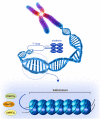The Alteration of Subtelomeric DNA Methylation in Aging-Related Diseases
- PMID: 30687384
- PMCID: PMC6333653
- DOI: 10.3389/fgene.2018.00697
The Alteration of Subtelomeric DNA Methylation in Aging-Related Diseases
Abstract
The telomere is located at the end of the chromosome and consists of a non-coding, repetitive DNA sequence. As the cell divides, the length of telomere gradually decreases. A very short telomere can terminate mitosis, and thus telomere length becomes a hallmark of cellular aging. The 500 kb region of each autosomal arm terminal is the so-called subtelomeric region. Both telomere and subtelomere have high-density DNA repeats. Telomeres do not contain genes or CpG sequences, while subtelomeres contain small amounts of genes and high-density CpG sequences, and DNA methylation often occurs in subtelomeres. Previous studies have shown that aberrant methylation of subtelomeric DNA exists in many diseases, and it has a certain effect on the regulation of telomere length. In this review, we focus on the correlation between subtelomeric DNA methylation and aging-related diseases. We also summarize the relationship between subtelomeric methylation and telomere length in different diseases.
Keywords: age-related disease; epigenetic modification; subtelomeric DNA methylation; telomerase; telomere length.
Figures
Similar articles
-
Aging-related alterations of subtelomeric methylation in sarcoidosis patients.J Gerontol A Biol Sci Med Sci. 2009 Jul;64(7):752-60. doi: 10.1093/gerona/glp049. Epub 2009 May 4. J Gerontol A Biol Sci Med Sci. 2009. PMID: 19414507
-
Aging-associated alteration of subtelomeric methylation in Parkinson's disease.J Gerontol A Biol Sci Med Sci. 2009 Sep;64(9):949-55. doi: 10.1093/gerona/glp070. Epub 2009 Jun 5. J Gerontol A Biol Sci Med Sci. 2009. PMID: 19502593
-
Regulation of telomeric function by DNA methylation differs between humans and mice.Hum Mol Genet. 2020 Nov 25;29(19):3197-3210. doi: 10.1093/hmg/ddaa206. Hum Mol Genet. 2020. PMID: 32916696
-
Human subtelomeric DNA methylation: regulation and roles in telomere function.Curr Opin Genet Dev. 2020 Feb;60:9-16. doi: 10.1016/j.gde.2020.02.004. Epub 2020 Feb 25. Curr Opin Genet Dev. 2020. PMID: 32109830 Review.
-
The gene mutations and subtelomeric DNA methylation in immunodeficiency, centromeric instability and facial anomalies syndrome.Autoimmunity. 2019 Aug-Sep;52(5-6):192-198. doi: 10.1080/08916934.2019.1657846. Epub 2019 Sep 2. Autoimmunity. 2019. PMID: 31476899 Review.
Cited by
-
Telomere-Related Disorders in Fetal Membranes Associated With Birth and Adverse Pregnancy Outcomes.Front Physiol. 2020 Oct 2;11:561771. doi: 10.3389/fphys.2020.561771. eCollection 2020. Front Physiol. 2020. PMID: 33123024 Free PMC article. Review.
-
TGF-β controls stromal telomere length through epigenetic modifications.3 Biotech. 2022 Nov;12(11):290. doi: 10.1007/s13205-022-03346-5. Epub 2022 Sep 24. 3 Biotech. 2022. PMID: 36276465 Free PMC article.
-
Human aging DNA methylation signatures are conserved but accelerated in cultured fibroblasts.Epigenetics. 2019 Oct;14(10):961-976. doi: 10.1080/15592294.2019.1626651. Epub 2019 Jun 12. Epigenetics. 2019. PMID: 31156022 Free PMC article.
-
Resistance and aerobic training increases genome-wide DNA methylation in women with polycystic ovary syndrome.Epigenetics. 2024 Dec;19(1):2305082. doi: 10.1080/15592294.2024.2305082. Epub 2024 Jan 21. Epigenetics. 2024. PMID: 38245873 Free PMC article.
-
DNA methylation-based estimator of telomere length.Aging (Albany NY). 2019 Aug 18;11(16):5895-5923. doi: 10.18632/aging.102173. Epub 2019 Aug 18. Aging (Albany NY). 2019. PMID: 31422385 Free PMC article.
References
Publication types
LinkOut - more resources
Full Text Sources
Research Materials


